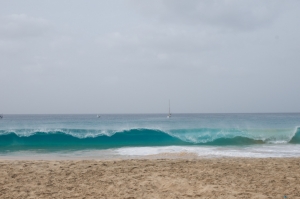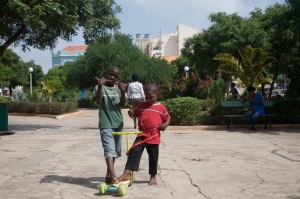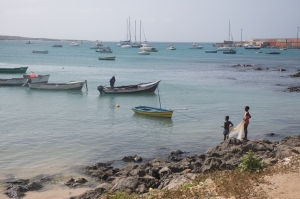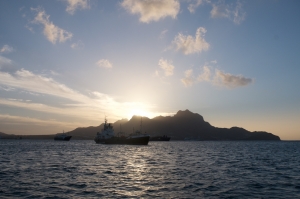
Maio, Cape Verde’s neglected island
Maio, a small downwind island of Cape Verde. An island neglected by tourists and the Cape Verde’s government due to the lack of transport to reach it. A small cargo boat stops here once to twice a week for mail and food. A plane comes from time to time, but the landing area is not lighted and the plane won’t come if he doesn’t have to go somewhere else after that. Therefore, Maio is one of the most, probably the most, authentic island of Cape Verde. The 7000 people living here are all very welcoming, doors are always open and the “thumb up” is mandatory to greet and thank anyone.
On November 11th in the evening, we dropped our anchor in Porto Inglès Bay, the most protected anchorage of the island, facing the main town. The following (early) morning, we can now discover the site. Water is crystal clear and trumpetfishs, clownfishs and parrotfishs are dancing around the boat. Thin sand beach edges the small and colourful town where all seem to be already in action. Fishermen are back with barques full of freshly caught tunas. Reaching the shore is dangerous. The shore break is high. We must wait for the right moment or the punishment will be unquestionable. Waves will return the dinghy and us with it. Once ashore, we meet our local contact: Carolyn, a New Zealander expatriate in Maio since roughly 10 years. She is the director of a small bar on the beach. She will introduce us to the island’s hospital. It is probably more a health centre as no big operations take place here.
After introducing the filter to the centre’s director and medical staff, we are going into a tour of the island to equip each smaller clinics. Most of the time, it is just a small house managed by the village’s health supervisor. This way, 15 filters have been put in place for the health centre and clinics of the island.
Thanks to Carolyn, we then meet Manuel Ribeiro, President of Maio. In Cape Verde, there is a central government and local government for each of the islands, with each time a president and ministers. The President explains us the island’s situation regarding access to drinkable water. It’s not raining much in Maio, only few days in the last three years. Three new desalination stations have been installed recently on the island. This water is therefore, in theory, drinkable. However, sadly, the flow is not consistent and the population must store the water for sometimes-long periods. Furthermore, the pipes system is in a very bad shape and the water running out of the pipes is contaminated with bacteria. The President tells us renovations are planned. Watch this space.
Our next visit is to the Education delegate to Maio island. The project appeals to him, the filters too and he came with us in all the island’s schools. Our action finally takes all its meaning. The children are exceptionally focused, water is a real subject and they are aware of it. In each school of the island, we run a workshop to raise awareness among the kids. For this first session, Florence, a doctor from Lille, has come to assist us. She insists on the risks linked to undrinkable water, the importance of water treatment, hygiene and washing hands. Then we present the filter and install once of it in each class of each school. Teachers and children clearly understand the importance of cleaning the filter and each of them fill trusted with a great responsibility.
In total, 100% of health centres and 100% of classrooms (nursery school, primary and secondary schools) of the island are now equipped with a filter. We have distributed 50 of them. The result of our first action is as positive as it is promising. The enthusiasm was general and filters well welcomed. Cape Verde is the only country where we will be able to come back during our world tour. We now look forward to see again all those we’ve met during our time here and check if the filters have been as useful as we hope they will be.
Next stop, Haïti, and before that the crossing of the great Atlantic.




























































